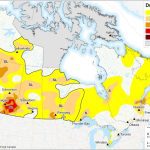MarketsFarm — Grain shipments through the Port of Thunder Bay are running well ahead of the year-ago level, with 3.747 million tonnes of grain shipped through the port on the northern shores of Lake Superior as of Aug. 31. That was up by 1.1 million tonnes from the previous year’s pace, but slightly behind the

Thunder Bay grain shipments up on year
Grain traffic contributes to increase in overall cargo handle

USDA adjusts soy, corn outlooks in September report
U.S. wheat usage, carryout estimates shift
MarketsFarm — The U.S. Department of Agriculture made a number of slight changes to its forecast on soybeans and corn for 2023-24, while keeping its domestic wheat numbers from August. USDA on Tuesday issued its monthly world agricultural supply and demand estimates, adjusting its forecast on this year’s soybean yields at 50.1 bushels per acre,

Numerous revisions to USDA’s data on Canadian canola
Outlooks raised for ending stocks, cut for domestic use
MarketsFarm — Canola production numbers for Canada as estimated by the U.S. Department of Agriculture underwent several changes for the 2022-23 and 2023-24 crop years. The data for Canada was among the estimates USDA’s Foreign Agricultural Service (FAS) put in its monthly report, Oilseeds: World Market and Trade. The FAS dropped its production estimates on

Australian crop estimates adjusted slightly lower
Crop seen down 34 per cent from last year
MarketsFarm — Total 2023-24 winter crop production in Australia, at an estimated 45.2 million tonnes, is expected to be 34 per cent off the record highs hit last year but slightly above the June forecast as upward revisions to canola and barley counter a downward revision to the wheat number, according to the latest crop

July canola crush sets new records
Soybean crush down slightly from last July
MarketsFarm — Statistics Canada reported very sizeable increases in the July canola crush when compared to a year ago. In fact, the month’s crush was not only a record for July but also for any month. Meanwhile, StatCan found the July soybean crush was slightly lower than in July 2022. The federal agency pegged the

Saskatchewan Crop Report: Dryness continues as harvest begins
Since April 1, the entirety of the province received 200 mm or less of rain
MarketsFarm – With the exception of a handful of areas, most of Saskatchewan remained dry for the week ended July 31 as harvest operations began in the province’s southwest and west-central regions. Areas north of Prince Albert and northwest of Kindersley, as well as inside and around Hudson Bay each saw more than 30 millimetres

Saskatchewan crops a mixed bag
Some cereal crops beyond harvesting with plans to salvage for feed
Marketsfarm – There was a wide mixture of the results in the latest crop report from Saskatchewan Agriculture. Parts of the province were hobbled by drought conditions, while other areas received upwards to 40 millimetres of rain following a series of thunderstorms during the week of July 18 to 26. The desiccation of pulse crops

Oilseed crush down, grain deliveries rise in June: StatCan
Canadian grain deliveries reached a three-month high in June
Marketsfarm – Statistics Canada (StatCan) released its June oilseed crush and grain delivery statistics, showing a small decline for the former, but a large gain for the latter from the month before. Oilseed processors in Canada crushed 772,345 tonnes of canola last month, as well as 139,164 tonnes of soybeans for the month of June

Manitoba crops holding on, need rain very soon
While crops in Manitoba remain in relatively good shape, the province’s July 18 crop report stressed that soil moisture reserves are inadequate to sustain those crops unless significant rain comes soon. Parts of the province received some rain with Elie, located in the central region, getting the most at 29.5 millimetres. A numbers of areas

Much of Canada abnormally dry or in moderate drought
MarketsFarm — In a stretch from the Atlantic to the Pacific Oceans, a wide swath of Canada was contending with dryness, according to the latest report from the Canadian Drought Monitor. As of June 30, about 60 per cent of the country was abnormally dry to being in a moderate drought, with 76 per cent

